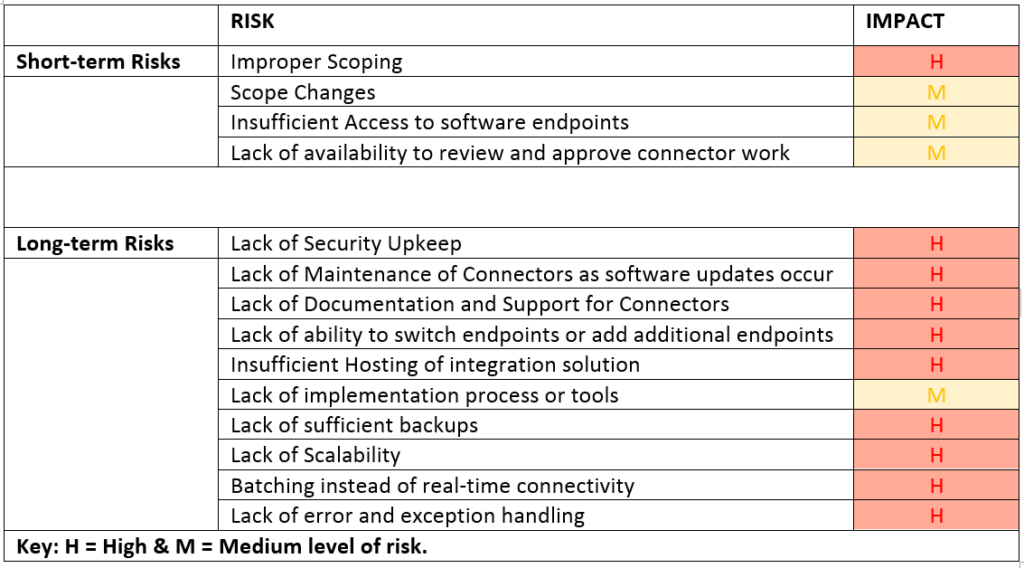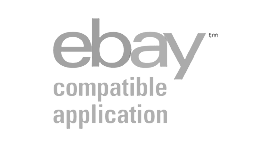When you’re ready to integrate your retail business systems such as your eCommerce, financial and brick-and-mortar software, there’s a few decisions you must make. You must decide which systems to integrate, how you’re going to connect them, and who you’re going to work with to make it happen. And while you undertake such a project, it’s best to stop and think about short-term and long-term risks you might encounter throughout the process.
Staying a few steps ahead is the only way to avoid winding up in a preventable, but regrettable situation such as lengthy, costly or mismanaged projects. At the end of that day, you want to walk away with a solution that works and not buyer’s remorse.
Taking a step back from your integration project, there are two areas that are crucial to plan for. These include short-term risks related to getting your retail business system integration up and running, and the equally important long-term risks that relate to properly maintaining and supporting those connections afterwards.
An integration project is more than just an initial launch and then a process that runs in the background of your business. You want to ensure that your integration evolves as your business takes on new order volumes, sales channels, or omnichannel capabilities. Having your inventory, orders, or other data stop flowing between your systems for any reason can cause a serious headache for you and your customers.
To make your planning process simpler, we’ve put together a Risk Assessment chart below. This chart is meant to help you measure twice, and cut once. You can use this chart when comparing systems and services to manage your integrations.
How to Asses Risk During Your Retail Integration Project
To start off, let’s take a look at common issues that can arise from the time you start planning your retail integration project, to the time that it launches.
Integration Project Short-Term Risks
Scoping Your Project
When connecting two software systems to automate data flows between them, it’s crucial to understand what fields of data need to be connected and what business processes you need to accommodate for. This will inevitably impact your scope or statement of work, identifying not only the fields that need to be mapped, but ways that data needs to be translated or changed along the way to be accepted by an endpoint system.
A lack of proper scoping upfront leads to scope changes later in your project, which can cause time delays and increased costs. In some cases, you may not have documentation about customizations and add-ons deployed to the software that you’re trying to connect. Or, you may not have access to the developers, IT professionals, and other people involved in the deployment and personalization of your software. Without these resources, changes down the road are more likely since it’s hard to plan for what you don’t know.
Key Takeaway: It’s important to have all stakeholders involved in creating your scope so that you don’t find out mid-project that a department like finance has requirements that you weren’t aware of.
Access to Your System
To connect systems, you need to be able to get data in and/or out of those systems. Whether it’s getting past firewalls, or simply generating the right logins for an API or FTP location, you need to be able to get what you need, when you need it. It’s important to make sure that any necessary vendors, such as a hosting company or Value Added Reseller (VAR) that control access to your software, are prepared to do their part in granting access for use by your integration partner.
When your integration partner doesn’t have the access they need, it can delay your project or prevent integrating your systems as you originally planned.
Key Takeaway: Be ready to understand and share access to the systems you need to connect at the beginning of your project.
Your Labor
When building a website, you need to give feedback on designs and other elements, and may need to provide content, such as for an “About Us” page. If a partner is completing your integration for you, they will most likely need information from you such as how you want to fulfill orders to generate the scope of work. They also might have you sign off on work at different parts of the project and take other necessary steps to complete a project.
Key takeaway: Expect to provide feedback to your partner throughout the integration project. Delays on your end will most likely impact your project’s launch dates.
Hardware and Software Requirements
To connect with other software, you’ll need your software systems to have a method for connecting. In some cases, you may need to pay for a module or access rights to be able to access an API, import and export flat files, or otherwise get data in and out of the software. In other cases, you may need to upgrade your SaaS license or hosting to accommodate the extra load that connecting data may require.
Key Takeaway: Be aware that integrating your systems could need more resources than you currently have. You should be able to work with your partner to understand and plan for these needs as they can affect your timeline and overall costs.
Now that’s all good and well… If you’re building on a solid base.
Choosing an Integration Approach: Long-Term Risks
Here are the top 10 things to watch out for when choosing your integration approach for connecting your systems that you might not have thought of yet:
- Security: Do you really want to risk your customers data and other sensitive data being breached? We know you don’t, so it’s important to understand how your integration solution is being tested for vulnerabilities to hackers. Will there be security audits? Penetration testing? Will the hosting and software layers be kept up to date to ward off new and evolving threats?
- Maintenance: As your software endpoints are upgraded, who is making sure that your integration platform is matching those changes? Without a maintenance plan, your integration solution may stop functioning, causing some pain and frustration for you, and your customers.
- Support & Documentation: If you’re having an issue with your data automation like when order fails, who will you turn to? How will you know if it’s an API issue, a firewall issue, bad data that an employee or vendor accidentally inserted into one of your software systems, or some other issue? If you’re relying on “a guy” who may be on vacation, tied up, or otherwise unavailable, and you don’t have adequate documentation, you may find yourself stuck up a creek without a paddle.
- Integration Approach: Is your integration a custom connection that ties your two systems directly together? Or, is your solution include a “hub” that sits between your endpoint systems that manages and executes your data integration? How your systems are tied together affects how easy is it to add an additional piece of software or upgrade one of your current endpoint systems. Depending on the integration approach, either of those scenarios could mean going back to the to the drawing board and starting a new project all over again. Outgrowing your integration can certainly be costly.
- Implementation: Depending on the solution, you might need to rely on your partner to connect your systems or it could be more DIY with point-and-click tools. If it’s the latter, do you have the resources in-house to perform the set-up? These differences will also affect costs. If your partner is required to set up the integration, expect there to be one-time set implementation costs.
- Hosting: Who hosts your integration solution? Is it scalable to handle increased volumes of data? Is it reliant on a particular data center or cloud provider to stay up and running? Is there an SLA to protect you from downtime? If your integration provider goes down, it’s your customers who suffer from lost orders, delayed order processing and more.
- Backups: What happens if there’s ever an issue where data stops flowing, or becomes corrupted at one of your endpoints? How will you recover? While we all hope such things never happen, it’s best to plan for such contingencies, just in case.
- Scalability: What’s the breaking point for your endpoint system? How many products and orders can it transmit at a time? There’s nothing worse than having a great sales day, and then finding out that the orders are stuck in data transmission instead of being picked, packed, and shipped.
- Batching: In a perfect world, all data would go through a real-time API (how software talks to other software). Even if one of your systems doesn’t have an API, data should be flowing to a system that does. With batching, you’re delaying the transmission of data. This can lead to problems such as inventory isn’t up to date, your orders aren’t moving to the software that you’re going to fulfill them from as quickly as they should, and so forth. API’s also have the benefit of using code to submit each piece of data, and to get a response from the receiving software. Which leads us to:
- Error and Exception Handling: Does your system know what to do if an order # already exists in the system it’s trying to insert an order into? What if it gets back a 4xx or 5xx error code? If your system doesn’t have sufficient handling, routing, and logging, you may find that your boat has holes in it, and you’re going to bailing water.

Use this chart to evaluate different solutions and partners. You can easily compare options by creating columns for each solution you want to compare.
Learn more about how nChannel’s middleware integration platform can connect your eCommerce systems to your EPP, POS, and 3PL systems.






Join The Conversation